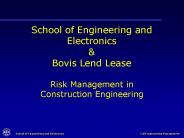Quantitative Methods for Flood Risk Management P.H.A.J.M. van Gelder $ $ Faculty of Civil Engineering and Geosciences, Delft University of Technology THE NETHERLANDS - PowerPoint PPT Presentation
1 / 33
Title:
Quantitative Methods for Flood Risk Management P.H.A.J.M. van Gelder $ $ Faculty of Civil Engineering and Geosciences, Delft University of Technology THE NETHERLANDS
Description:
Events with small probabilities and large consequences ... ML estimate of 1/100 year quantile is below the ... River Meuse discharges (1/1250 years quantile) ... – PowerPoint PPT presentation
Number of Views:162
Avg rating:3.0/5.0
Title: Quantitative Methods for Flood Risk Management P.H.A.J.M. van Gelder $ $ Faculty of Civil Engineering and Geosciences, Delft University of Technology THE NETHERLANDS
1
Quantitative Methods for Flood Risk Management
P.H.A.J.M. van Gelder Faculty of Civil
Engineering and Geosciences, Delft University of
Technology THE NETHERLANDS
- Workshop
- Statistical Extremes and Environmental Risk
- Faculty of Sciences
- University of Lisbon, Portugal
- February 15-17, 2007
2
Contents
- Introduction
- Extreme Value Statistics
- Types of Uncertainties
- Effect of Uncertainties on design
- Case study
- Conclusions
3
Introduction
- Events with small probabilities and large
consequences - Estimating the quantiles of the order of 1/100 -
1/10,000 years of - water levels
- river discharges
- precipitation levels
- etc.
4
Staatscommissie voor den Waterweg, 1920
5
Striking observations
- Design of breakwater
- ML estimate of 1/100 year quantile is below the
largest observation during a 10 year period (see
figure) - Optimal decision-making from which viewpoint?
6
(No Transcript)
7
Threshold selection
- 1/10,000 year quantiles of sea levels at Hook of
Holland with 2 parameter estimation methods for
GPA distribution
8
River Meuse discharges (1/1250 years quantile)
9
Homogeneity of datasets (generated by the same
process?)
10
Wave heights at Karwar India
11
Karwar
12
Karwar
13
Extreme Value StatisticsMany available methods
- Moments
- Least Squares
- Maximum Likelihood
- L-Moments
- Minimum Entropy
- Bayesian
- all refined mathematics
14
Lack of data
- N 101 102 observations
- RP 102 103 104 years
- Homogeneity
- Stationarity
15
Not only mathematics, but physical insight
- Discharge water content x orographic x synoptic
(Klemes, 1993) - Storm surge tide wind setup
- Joint distribution of waves and storm surges
(Vrijling, 1980)
16
(No Transcript)
17
- Still extrapolation with huge uncertainty
- wait for more data
- postpone the constructions of the port, sea
defence, or dam - the most rational way to decide on the size of
the structure under uncertainties
18
- If we see the design as a decision problem under
uncertainty, there are more uncertainties - extrapolation uncertainty
- model uncertainty
- uncertainty of the resistance
- ...
19
Types of Uncertainties
20
- Z R S U
- R Resistance
- S Loads
- U Uncertainty
21
Probability Distributions of ?
22
Policy Implications
- Three Possible Reactions
- 1 Accept the difference and do nothing.
- 2 Heighten the dikes in order to lower the new
probability of flooding to the old value. - 3 Reduce some uncertainties by research before
deciding on the heightening of the dikes to the
optimal probability of flooding.
23
Case study
- Lake IJssel
- 1200 km2
- very shallow
- steep waves
24
Physical and reliability model
- Wave run-up z2 (Van der Meer)
- Wind surge ? (Brettschneider)
- Reliability function
- Z K - M - ? - z2
- Crest Level K
- Lake Level M
25
Uncertainties
- Intrinsic
- Lake Level
- Wind Speed
- Statistical
- Lake Level
- Wind Speed
- Model
- Surge
- Oscillations
- Significant wave height
- Wave steepness
- Wave run-up
26
FORM Results of Rott. Hoek
27
Contributions of Uncertaintiesat Rotterdamsche
Hoek
28
Rotterdamsche Hoek
29
Reliability-based Optimizationimprove or
postpone
30
CONCLUSIONS
- Extreme value theory in the most refined form is
less fruitful - The limited amount of data and the various
sources of uncertainty have to be seen in the
context of the design decision - All uncertainties have to be taken into account
in the design decision
31
Conclusions
- A method to get insight in the effect of
uncertainty in hydraulic engineering problems is
described. - The most influential random variables are
generally the ones with inherent uncertainty
(this uncertainty cannot be reduced).
32
Conclusions
- In case of exponential distribution normal
uncertainties, a simple expression for the
economic optimal probability of failure can be
derived - Larger location parameter leads to higher optimal
design, but has no influence on the optimal
probability of failure - Larger scale parameter leads to smaller optimal
design and higher probability of failure
33
Conclusions
- More options than structural
- reduce uncertainty by data collection or research
- decrease loads (µ down or s down)
- increase resistance (µ up or s down)
- reduce damage in case of failure
- Economic optimal decisions should be proposed for
the height as well as the timing of the
improvement































